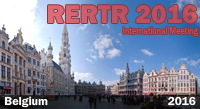 2006 International RERTR Meeting
2006 International RERTR Meeting
Abstracts and Available Papers Presented at the Meeting
Characteristics of the WWR-K Reactor Core with Low-Enriched Uranium Dioxide Fuel
F. Arinkin, P. Chakrov,
L. Chekushina, Sh. Gizatulin, K. Kadyrzhanov, E.
Kartashev,
S. Koltochnik, V. Lukichev, V.Nasonov, N. Romanova,
A.Taliev, Zh. Zhotabaev
Kazakhstan Ministry of Energy and Mineral Resources,
The Institute of Nuclear Physics affiliated to the
Kazakhstan National Nuclear Center
ABSTRACT
The neutronics and thermal-hydraulic characteristics of the core with eight- and five-tube FAs are presented. The FA face-to face size is 66.3 mm. The net loads of uranium-235 per the eight-tube FA (FA-1) and the five tube FA (FA-2) are ~253 and ~202 g respectively. Five-tube FAs are intended to arrange original channels of the operational elements of the WWR-K CPS. The uranium density of the UO2-Al fuel meat material is 2.8 g·cm-3.
The core initial charge is 16 FA-1 and 10 FA-2 (including three AZ shut-down elements, six KO shim elements and the AP automate control element) with the reactivity margin comprising 7.2%Δk/k and the net CPS worthies comprising 9.0%Δk/k (KO and AP) and 2.7%Δk/k (AZ). For the 6-MW power rating, the thermal neutron flux density in the core central channels and in the channels located in the reflector comprise, respectively, ~2.1·1014 and ~5.0·1013 cm-2·s-1; the reactor operation cycle reaches 90 days.
Around the core the side beryllium reflector is formed from beryllium pieces step by step, by portions determined by he net efficiency of the shim elements KO and the automate rod (AP). With 24 beryllium pieces (a single row around the core) and the 50-% peak burnup achieved, the net operation cycle duration reaches ~320 days. The thermal neutron flux density in the reflector channels has increased up to 7.2·1013 cm-2·s-1. The CPS control rod efficiency has increased up to 11.4%Δk/k - for KO and AP, and up to 4.7%Δk/k - for AZ.
Further, as the FAs burnt
off are unloaded, beryllium blocks are loaded instead,
up to 52 pieces (full occupation of the free core
cells). The net efficiency of KO and AR has increased up
to 12.4%Δk/k; the thermal neutron flux density in the
reflector channels has comprised ~9.3·1013 cm-2·s-1.
Thermal-hydraulic calculations have proved the core
heat-engineering reliability.
![]() Full paper in PDF format
Full paper in PDF format
- Characteristics
of the WWR-K Reactor Core with Low-Enriched Uranium
Dioxide Fuel, F. Arinkin et al.
[PDF, 359KB, 9 pages]
IMPORTANT NOTE:
Download the latest and free version of
Adobe's
Reader to view documents in PDF format. If you have questions about
or problems with downloading, installing or using Adobe's Reader, please visit the
Adobe
website.
![]()
Problems viewing/ printing PDF files
Should you experience problems with viewing/printing the PDF files:
![]() PDF Help Notes (link opens in new browser
window)
PDF Help Notes (link opens in new browser
window)
Contact:
Dr. Jordi Roglans-Ribas
Technical Director, RERTR Department
Nuclear Engineering Division – 362
Argonne National Laboratory
9700 South Cass Avenue
Argonne, IL 60439
Fax: +1 630-252-5161
![]()




